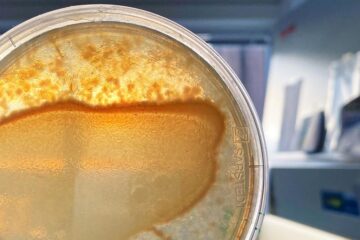Link between rapid Antarctic glacier formation and ocean acidity

The largest single glaciation event during the past 65 million years occurred in two rapid steps, and coincided exactly with an extreme decrease in indicators of ocean acidity, according to research published today in the journal ’Nature’.
The international team, including scientists from the Southampton Oceanography Centre and Cardiff University, have shed new light on the nature and speed of glaciation on the Antarctic continent around 34 million years ago.
Geologists analysed tiny fossil carbonate shells of foraminifera, animals the size of pinheads living on the sea floor, that record past ocean water temperatures, and the total amount of ice present in the polar ice caps. They say that the speed of glaciation during that period was much faster than previously estimated, and happened at exactly the same time as a big increase in the depth of the so-called submarine carbonate ’snow-line’ that marks out the area of sea-floor over which calcium carbonate is deposited, showing that the oceans became less acidic after the world entered an ’ice-house’ state – a period when the Earth had ice at both poles.
Lead author, Dr. Helen Coxall, said, „Our data show that an increase in carbonate deposition took place an order of magnitude faster in the Pacific than previously published, in the twinkling of a geological eye, and not as a single event but in two 40 thousand year steps, separated by an intermediate plateau of 200 thousand years.“
The work, partly funded by the Natural Environment Research Council, shows how rapidly, in geological terms, major changes in Earth’s system can occur.
Dr Paul Wilson, one of the two co-chief scientists during the expedition, said „This research is not only concerned with the climate many million years ago. Researching and understanding ’extreme’ climate events from the geological past allows us to better tune climate models, to understand present and future events, and the response to perturbations.“
The scientists used a correspondence between the measurements from microfossil shells and periodically re-occurring changes of the Earth’s orbit around the sun to establish the relative duration of events, stressing the importance of obtaining undisturbed and high-quality sediments from the deep oceans.
All of the authors participated in an international Ocean Drilling Program expedition to the equatorial Pacific in 2001 in order to recover the sediments from close to 5 km below the sea surface, and several hundred metres below the ocean floor.
Research is underway to figure out what links Antarctic glaciation and ocean acidity and to provide additional high-resolution studies of the climate system over more extended periods of time.
Media Contact
Weitere Informationen:
http://www.nerc.ac.ukAlle Nachrichten aus der Kategorie: Geowissenschaften
Die Geowissenschaften befassen sich grundlegend mit der Erde und spielen eine tragende Rolle für die Energieversorgung wie die allg. Rohstoffversorgung.
Zu den Geowissenschaften gesellen sich Fächer wie Geologie, Geographie, Geoinformatik, Paläontologie, Mineralogie, Petrographie, Kristallographie, Geophysik, Geodäsie, Glaziologie, Kartographie, Photogrammetrie, Meteorologie und Seismologie, Frühwarnsysteme, Erdbebenforschung und Polarforschung.
Neueste Beiträge

Das Mikrobiom verändert sich dynamisch und begünstigt wichtige Funktionen für den Wirt
Ein interdisziplinäres Forschungsteam des Kieler SFB 1182 untersucht am Beispiel von Fadenwürmern, welche Prozesse die Zusammensetzung des Mikrobioms in Wirtslebewesen steuern. Alle vielzelligen Lebewesen – von den einfachsten tierischen und…

Wasser im Boden – genaue Daten für Landwirtschaft und Klimaforschung
Die PTB präsentiert auf der Woche der Umwelt, wie sich die Bodenfeuchte mithilfe von Neutronenstrahlung messen lässt. Die Bodenfeuchte hat nicht nur Auswirkungen auf die Landwirtschaft, sondern ist als Teil…

Bioreaktor- und Kryotechnologien für bessere Wirkstofftests mit humanen Zellkulturen
Medizinische Wirkstoffforschung… Viele Neuentwicklungen von medizinischen Wirkstoffen scheitern, weil trotz erfolgreicher Labortests mit Zellkulturen starke Nebenwirkungen bei Probanden auftreten. Dies kann passieren, wenn zum Beispiel die verwendeten Zellen aus tierischem…





















